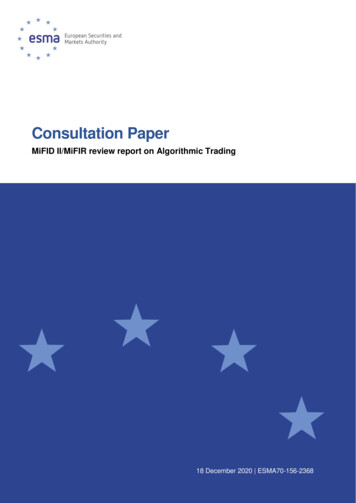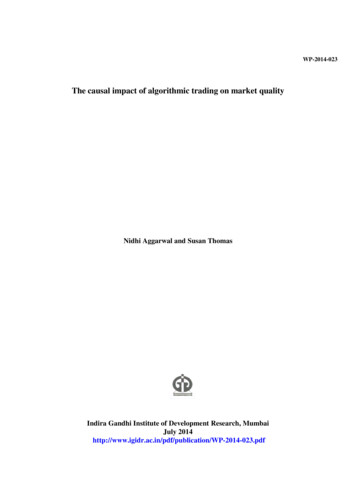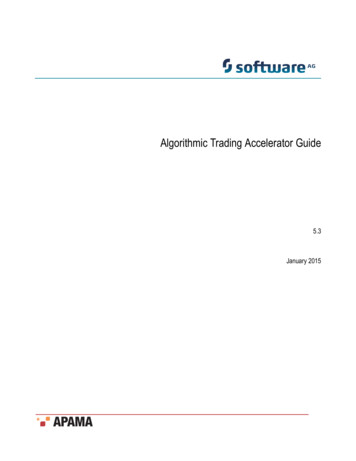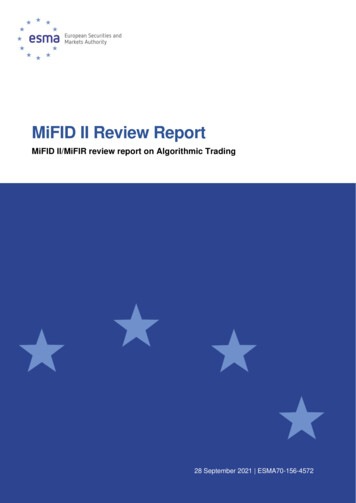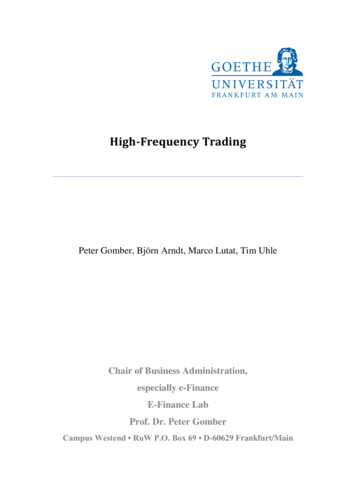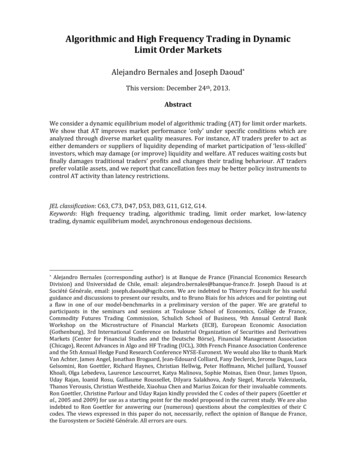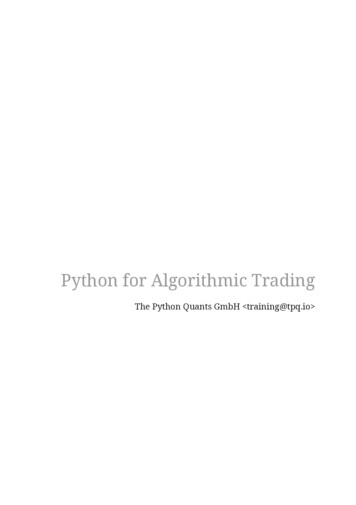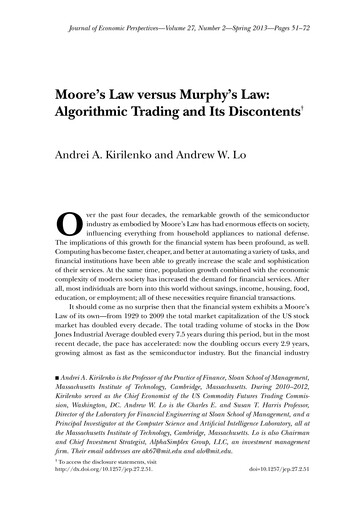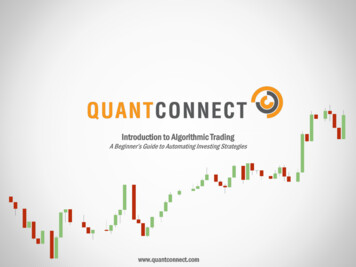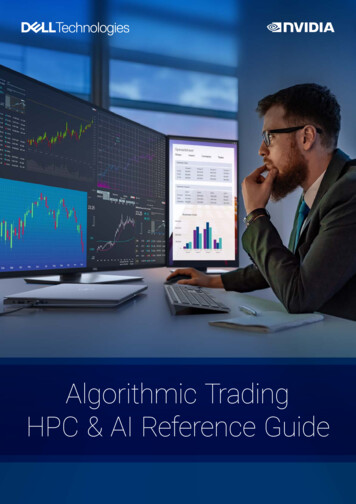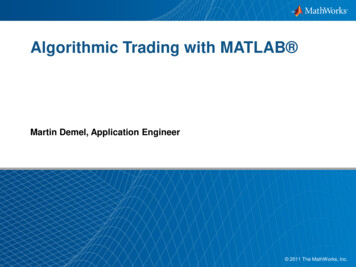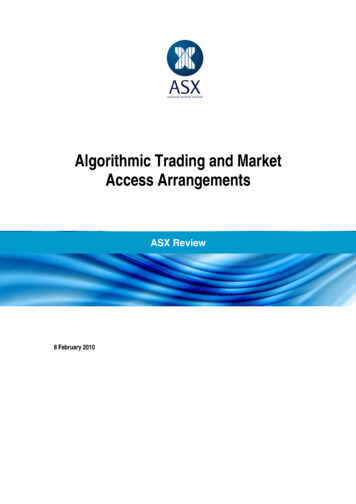
Transcription
Algorithmic Trading and MarketAccess ArrangementsASX ReviewBroker TradesMessage Specification8 February 2010
TABLE OF CONTENTSExecutive Summary. 3Summary of the ASX Review Findings - Backward-Looking. 7Summary of the ASX Review Findings - Forward-looking . 9Summary of Intended Actions and Recommendations. 10Paper Structure . 13PART ONE: BACKWARD-LOOKING FINDINGS . 141.Terminology . 142.Current ASX Practices. 172.1Access . 172.2Algorithms in Use. 192.3Trading Volumes . 202.4Metrics . 222.5Supervision . 233.SIRCA Research: Impact of Algorithms on Market Quality. 244.Overseas Comparison . 25PART TWO: FORWARD-LOOKING FINDINGS . 285.Overview of Future Trends . 285.1Macro-Trends: Regulatory Environment . 285.2Micro-Trends: Algorithm Development . 296.Operational Issues and Recommendations. 306.1Risks and Controls. 306.2Enhanced Direct Market Access Arrangements . 316.3Algorithm Testing. 326.4Trading Aberrations . 336.5Trade Cancellations / Wash Trades. 347.Supervision Issues and Recommendations . 367.1Scope of Operating Rules. 367.2Client ID . 377.3Market Manipulation . 387.4Liquidity Detection . 417.5IT Infrastructure, Security and Controls. 41Appendix 1: SIRCA Report . 43Appendix 2: Technical Information on ASX Current and Proposed DMA Models. 532
Executive SummaryBackgroundIn July 2009, having observed sustained growth in algorithmic trading, the Australian Securities Exchange(ASX) initiated a review of algorithmic trading and market access arrangements in Australia (‘the ASXReview’)1. The ASX Review was aimed at determining the impact of algorithmic trading in Australia,assessing the future growth of algorithmic trading, and identifying ways to meet demand from customersfor alternative access arrangements to ASX’s market without undermining market integrity. While ASXhas been active in facilitating what has become a global phenomenon of algorithmic trading since 2006,and remains committed to developing liquidity through algorithmic trading and enhanced market access, itis mindful of ensuring that its ongoing development does not have a negative impact on market integrity orquality. ASX also notes that other jurisdictions in North America and Europe have since commencedsimilar reviews of the impact of algorithmic trading.The Australian Securities and Investments Commission’s (ASIC) Market Assessment Report of ASX forcalendar year 2008, released in September 2009, also referred to the ASX Review. ASIC recommendedthat certain issues be covered, including the adequacy of ASX operating rules. This report has beenprepared to convey to ASIC the findings of ASX’s Review as well as identify initiatives that ASX shouldimplement in its capacity as a licensed market operator.Subsequent to the objective setting and commencement of the ASX Review, the Australian Governmentannounced the transfer of certain supervisory responsibilities from ASX to ASIC, scheduled to becompleted in the third quarter of 2010.2 The transfer of these responsibilities means that some (but by nomeans all) of the recommendations in the ASX Review are now provided for consideration by ASIC as theprospective whole-of-market supervisor, rather than for ASX as a market operator.This paper is also being released more widely to help develop a broader understanding of the issuesraised by algorithmic trading both for today and in the future, as well as to begin to address a number ofconcerns from some retail investors about algorithmic trading.IntroductionWhat is algorithmic trading?While trading has occurred electronically for many years, it has been in the past five years that equitymarkets globally have undergone the most profound technological change. Advances in technology havedramatically altered the way in which orders are executed. Rather than orders being entered into themarket manually by broker operators, there has been an increasing trend towards orders being generatedby computer algorithms seeking to minimise market impact costs for clients and to capture proprietarytrading opportunities.There is no commonly agreed definition of algorithmic trading. It describes a very broad range of tradingactivities utilising computer technology. For the purposes of the ASX Review, algorithmic trading isdefined as computer generated trading activity whose parameters3 are determined by strict adherence to apredetermined set of rules aimed at delivering specific execution outcomes.http://www.asx.com.au/about/pdf/mr 280909 asx response asic group activities report09.pdfRelevant excerpts from the Government’s announcement read: “The Government has decided to provide for the AustralianSecurities and Investments Commission (ASIC) to perform supervision of real-time trading on all of Australia's domestic licensedmarkets. This change will mean that ASIC will now be responsible for both supervision and enforcement of the laws againstmisconduct on Australia's financial markets The changes will mean that ASIC will become responsible for supervising tradingactivities by broker participants which take place on a licensed financial market, while individual markets – such as the AustralianSecurities Exchange (ASX) - will retain responsibility for supervising the entities listed on them.” The full text of the Minister’sannouncement is available ?doc pressreleases/2009/013.htm&pageID 003&min ceba&Year 2009&DocType 03 For example: volume, price, security, market, type, timing of execution, news event.123
The emergence of algorithmic trading has resulted in a substantial increase in the speed of tradeexecution and the number of transactions executed on a daily basis, and a significant reduction in theaverage value of each trade. Technological advances have also driven the demand for new accessarrangements (such as direct market access (DMA) and co-location facilities) as both brokers and endusers seek to improve their speed of trade execution.Impacts of Algorithmic TradingASX has played an active role in facilitating algorithmic trading through the ongoing investment intechnology capacity, changes to its fee structures, and the introduction of co-location services. In doingso, ASX acknowledges the positive effect that algorithmic trading can have on liquidity - to the benefit ofboth ASX and the broader market.ASX anticipates that algorithmic trading in Australia will increase more rapidly in the coming years. Thiswill be fuelled by further technological advances and the ongoing sophistication of a diverse range ofinvestors. In particular, algorithmic trading will, in all likelihood, significantly increase if the Governmentgrants licences to alternative market operators to trade ASX listed securities. This is becausesophisticated algorithmic traders, not yet active in the Australian market, will seek to take advantage ofnew arbitrage opportunities that would become available as a result of liquidity fragmentation acrossdifferent trading platforms.Indeed, new market operator aspirants have indicated their intention to bring these new ‘liquidity providers’to Australia. This is an example of how regulation can enable or even create trading opportunities thatwere previously not possible or profitable – and it generates implications for brokers and for lesssophisticated investors in terms of trading costs and trading/investment decisions. It also has profoundimplications for supervisors and market operators in terms of seeking to preserve market and operationalintegrity, and it raises some important public policy issues about balancing the interests of short-termtraders with those of long-term investors.A significant proportion of algorithmic trading (both buy and sell side) is conducted for market impactminimisation, arbitrage, asset allocation, and many other traditional trading strategies. However, a smallnumber of trading algorithms in use internationally employ strategies that, if they became widely used inAustralia, would raise questions about their impact on the supervision of the local equity market and onnon-algorithmic market users (particularly retail investors). The ASX Review noted that regulators in otherjurisdictions, where the evolution of algorithmic trading is more advanced than in Australia, are only justbeginning to understand and address the emerging issues that these algorithms raise.When considering these complex issues, it is important to avoid simplistic characterisations. Algorithmictrading is not inherently harmful to market integrity or quality – in fact algorithmic trading plays animportant role in developing liquidity. Equally, algorithmic trading is not, by definition, inherently good formarket quality and integrity. Significant order flow generated by an algorithm should not be considered assynonymous with ‘liquidity’, and therefore desirable regardless of its impact. Rather, the growth inalgorithmic activity has generated new issues which to date have not been evident in Australia, but forwhich the Australian regulatory framework and whole-of-market supervisory infrastructure needs to beequipped.The experience overseas and lessons for AustraliaThe regulatory framework is a key determinant of likely future trends in algorithmic trading and a keyprotector of market integrity and quality. The Australian Government has previously indicated that it maymove toward a market structure with multiple platforms trading the same securities. It is thereforeappropriate to look overseas to jurisdictions where multiple platforms trading the same securities alreadyoperate, to help inform how changes to Australia’s equity market microstructure are likely to affect thegrowth of algorithmic trading, to examine what issues this would raise, and to avoid some of the pitfallsencountered elsewhere. In doing this, it is also important to acknowledge the differences between the4
Australian market and other jurisdictions - for example, the absence of the practice of ‘flash orders4’ on theASX cash equity market and the relatively small scale of the Australian market.In North America and Europe, the impact of algorithmic trading, as well as the impact of liquidityfragmentation across competing market operator environments, has raised complex supervisory issues.In the past month, the US Securities and Exchange Commission (SEC) has published a consultationpaper as part of its review of US equity market microstructure and, specifically, of the impact of highfrequency trading (a subset of algorithmic trading described later in this paper).The SEC’s review attempts to reconcile the role of the market as a means of facilitating efficient capitalformation and risk transfer, with the arguably unforseen increase in high frequency trading volumes thathave flowed from regulatory changes designed to facilitate competition between trading venues. The SECreview also notes that markets are not ends unto themselves - rather, they are the means for investors tosave for the future, and to allocate those savings efficiently among companies that put that capital to workin the economy.The SEC review underlines the importance of Government decision-making on equity market microstructure reform. Such reform must ensure that public policy settings balance the interests of short-termtraders and long-term investors, and are not compromised in the short-term pursuit of ’liquidity’ or bycreating an inadvertent bias towards a subset of algorithmic market users.In Australia, macro or whole-of-market impacts from any market microstructure reform need to beexamined as part of the Government’s consideration of whether to grant licences to alternative marketoperators to facilitate trading in ASX listed securities. In the event that licences are granted, theGovernment must give careful consideration to the appropriate legislation and regulation (through thecreation of comprehensive rules common to each market operator) in order to preserve market quality andintegrity, and to ensure that change is in the broad public interest, not only in the interests of promotingcompetition between market operators.The importance of these issues and the prospect of exponential growth in algorithmic trading in Australia,makes the content and publication of the ASX Review timely.What the ASX Review doesFirstly, the ASX Review assesses the impact that algorithmic trading and changes to access arrangementshave already had on ASX’s markets. While ASX has for some time invested in significant enhancementsto its technology infrastructure, functionality, rules framework, pricing and supervisory processes to bothaccommodate algorithmic trading and to manage its impact on the market, the ASX Review identifiesareas where ASX can (and will) further improve the operation of its cash equity market.Secondly, drawing on the experiences of markets in North America and Europe, the ASX Review looksforward and anticipates the issues that are likely to arise as the growth of algorithmic trading accelerates inAustralia. ASX is currently responsible for both operating the market and for supervising broker conduct inrelation to the market. In the third quarter of 2010, ASIC is scheduled to take over responsibility for certainmarket monitoring and broker supervision functions, and for all investigation and enforcement activity. Aswell as making recommendations for actions to be taken by ASX to further improve the operation of itsmarkets, the ASX Review also makes recommendations for consideration by ASIC. Theserecommendations are made to ASIC, for the most part, as a practical consequence of the transfer ofsupervisory responsibilities from ASX to ASIC.Importantly, the substance of several of the recommendations results from the findings of the ASX Reviewregarding the effect of a multi-market operator environment on algorithmic trading. ASX makes theserecommendations in the interests of ensuring that effective whole-of-market supervision is maintained andconfidence in the integrity and quality of Australia’s exchange-traded markets is preserved.The disclosure of an unexecuted order by an exchange to algorithmic traders to provide an opportunity to trade prior to fulfillingthe exchange’s obligation to route the order to an alternative platform displaying a better price.45
On 28 January 2010 the Government announced its intention to strengthen ASIC’s powers in relation toinsider trading and market manipulation. Ensuring that ASIC has the appropriate surveillance tools andcapabilities is an important step in enabling ASIC to effectively use those strengthened powers. ASXbelieves that supervisory effectiveness would be improved further by a comprehensive review of themarket manipulation provisions within the Corporations Act to ensure that these are adequately drafted tocapture contemporary forms of trading and to provide for a more granular definition of marketmanipulation.ScopeThe scope of the ASX Review has been extensive, and has involved:1. Identifying the generic types of algorithms that are currently employed and the algorithmicproducts currently offered by brokers;2. Estimating current and future trading volumes executed through these algorithms;3. Identifying potential supervisory and operational issues;4. Identifying initiatives to enhance the operational environment (over and above improvements toASX systems, rules and processes already underway);5. Identifying changes to the ASX rule framework to more efficiently facilitate user access (includingintroducing ‘Sponsored Access’ for ASX);6. Identifying potential regulation, rule, procedure and functional improvements to the controlfeatures available to ASX for the cash equity market, recognising the changes which areanticipated to be made to ASX’s role from the third quarter 2010;7. Identifying potential rule, procedure and functional improvements to the control features availablefor participants to manage their clients; and8. Making recommendations for the whole-of-market supervisory infrastructure to enhance thesupervisory environment post the scheduled transfer of certain market supervisoryresponsibilities in the third quarter 2010.The specific issues which ASIC asked ASX to consider were:1. The adequacy and consistency of ASX group’s operating rules and procedures, in settingminimum risk and operational requirements for participants in enabling direct market access toclients;2. Whether the operating rules set suitable standards of accountability by participants for the tradingactivities of their direct market access clients;3. Whether retail investors are adequately informed about the nature of the direct market accessservices and the characterisation of the securities and investments that they acquire via thisservice; and4. Developments in international best practice standards for the provision of direct market accessservices and the supervision of algorithmic trading.All findings and recommendations contained within the ASX Review reflect ASX’s understanding ofdevelopments in international best practice adapted for the Australian market context.6
MethodologyIn conducting this Review, ASX formed an internal project team with representation from across theorganisation, including Market Operations, Regulatory and Public Policy, ASX Markets Supervision(ASXMS) and Business Development. The team focused on delivering the scope of the Review by a threestage process:1. Desktop research and reviews of academic and industry literature, complemented by a mix ofinternal workshops, conference attendance, and some external meetings with ASX Participants;2. Face to face meetings with supervisory bodies (Finra5, NYSE Regulation, IIROC6, FSA),exchanges and electronic crossing networks (NYSE, Nasdaq, BATS, DirectEdge, TMX, LSE),market users and technology providers in North America and Europe to learn from theirexperiences; and3. Research commissioned from SIRCA, an independent research body, to look at the effects ofalgorithmic trading on ASX equity market quality from 2006 to 2009.A summary of the findings of the ASX Review are included below, and are dealt with in more detail in thebody of this document.Summary of the ASX Review Findings - Backward-LookingThe ASX Review found that, to date, there have been no significant supervisory issues raised byalgorithmic trading on the ASX cash equity market. While there has been an increase in customercomplaints to ASX about ‘unusual’ patterns of behaviour attributable to algorithmic trading, ASXMSinvestigations of these complaints have not identified any instances of market manipulation directly relatedto algorithmic trading. That said, the ASX Review found that orders entered by algorithms can createdynamic price movement not previously observed by investors that can (from an historical interpretationperspective) appear to be prima facie evidence of manipulation.In order to better understand the effect of algorithms, it is necessary to understand what algorithms areseeking to achieve. Execution algorithms were developed to minimise the market impact of large ordersand therefore reduce the costs of trading. The most common of these is VWAP – an algorithm designedto achieve, or better, the volume weighted average price of a security over a day. VWAP reportedlyremains the most commonly used execution algorithm for buy-side traders in the Asian region.Situational algorithms have evolved more recently and are more sophisticated algorithms, which seek toprofit from changes in data, information and events. In contrast to an execution algorithm that is used toexecute a pre-existing order in the most efficient manner, a situational algorithm will create orders from acomputer-generated algorithmic strategy as well as execute the orders as efficiently as possible. Generallyspeaking, execution algorithms are used by investors7, while situational algorithms are used by traders.The ASX Review concluded that education of stakeholders, investors and issuers is needed to develop abroader understanding of both execution and situational algorithmic trading and to address some of themisconceptions (and hence prejudices) about their purpose and uses. In anticipation of the inevitable risein complaints that will occur as algorithmic trading increases and as the price discovery process becomesmore complex and dynamic, it is important to understand execution and situational algorithms whenattempting to identify potential integrity issues or their impact on market quality.Empirical research undertaken by SIRCA (attached under Appendix 1) concluded that there has been anincrease in algorithmic trading over the past three years, but, importantly, that algorithmic trading has notled to significant changes in the quality of ASX’s markets. Market metrics such as bid-ask spreads havenot significantly changed, nor has a correlation been found between the long-term trend in liquidity andvolatility, and the increasing use of algorithms.Market supervisor for Nasdaq and other US trading platforms.Canada’s cross-market supervisor.7 Albeit many investors do not use algorithms at all.567
Having said this, the research does show that market depth8 improved significantly towards the end of theglobal financial crisis, increasing by around 250% between March and September 2009. This may be as aresult of the lifting of the regulatory short selling ban put in place in the aftermath of the collapse ofLehman Brothers in September 2008, the general recovery in market confidence, as well as the increaseduse of the ASX co-location facility by algorithmic traders. It also coincided with a significant increase in thenumber of orders generated on ASX. However, the reasons for the change are not as important as the factthat these significant increases in market depth and order proliferation do not appear to have translatedinto significantly greater turnover (as seen in the following table).While the ASX Review draws no firm conclusions as to why this has occurred, it does raise questions as towhether definitions of ‘liquidity’ need to be re-examined – particularly since orders in the market may onlyappear for very short periods of time (consistent with the trading strategies of some algorithmic traders).‘Liquidity’ and ‘order proliferation’ should not be used inter-changeably, as the relationship between themis poorly understood.Considering that increased use of ‘dark pools9’ in Australia has occurred over the same period asincreased market depth and order proliferation in the central market, this provides some prima facieevidence that the additional orders contributing to increased market depth are either not accessible orattractive to those that have directed order flow to ‘dark pools’. ASX intends to commission furtherresearch from SIRCA to identify appropriate methodologies to define and analyse ‘liquidity’. Theidentification of genuine liquidity providers (distinct from order proliferators) is a key objective of ASX toensure fee structures and incentives are set appropriately. For policy makers, distinguishing betweenliquidity and order proliferation is important when considering the benefits and costs of facilitating thetrading of securities on multiple platforms.10Operationally, the ASX Review noted that there has been a significant change in a number of metrics asshown in the table below, with value traded reflecting the impact of the GFC:ASX Cash Equity Market Trade Metrics:200720082009Value Traded (billion) 1,576.4 1,393.5 1,153.6Number of Trades (million)1168.2106.3115.8Number of Order Book Changes (million)333.9562.7826.7Average Trade Size 23,092 13,108 9,961Number of Errors12242012Number of Crossing Trades Cancelled13126,854195,677338,951Most notably, there has been a significant increase in trading activity (in terms of orders and trades) aswell as a reduction in the average trade size. These are all prima facie evidence of an increase in the useof algorithmic trading in Australia14. Also notable is the fact that the number of errors over the same periodhas declined. However, there has been a significant increase in trade cancellations, as a result of anThe value of unexecuted (or ‘resting’) buy and sell orders in the order bookBroadly speaking, a dark pool is a non-public, non-transparent venue for executing orders away from the central market.10 The SEC discusses the use of market quality metrics in its recent Concept Release on Equity Market Structure, requestingcomment on whether new measures of market quality are needed to reflect changes in market microstructure. .pdf page 35.11 Includes billable and non-billable trades.12 A trade that is executed sufficiently away from the market price that ASX in consultation with the Dispute Governors Committee,determines that the trade will be cancelled. The error can be identified by ASX, the Participant or a third party, and ASX does notseek counterparty approval for the cancellation.13Many of these cancelled trades may have been subsequently reported at corrected prices or volumes.14 Algorithmic trading is not specifically identifiable through ASX trade data as it is transmitted to ASX through generic interfaces inthe ASX trading platform that may comprise a mix of manual and algorithmic order flow.898
increase in the number of wash trades15, and this is consistent with the increased use of algorithms.Trade cancellations impact on the accuracy of VWAP and TWAP16 calculations if trades are cancelledafter the average price has been calculated. The ASX Review identified a range of measures that ASXshould implement to reduce the instances of trade cancellations.In addition, the ASX Review identified improvements to ASX processes for granting and removing accessto the market. These changes would reduce risks to market integrity in the instance of a malfunctioningalgorithm by improving the speed that ASX can remove access to the market for such an algorithm.Furthermore, the ASX Review acknowledges the demand from brokers to provide their clients withenhanced DMA services, and that ASX must develop the appropriate operational and risk managementmechanisms before providing those services, as well as ensuring that brokers have appropriate controls inplace to manage client access.While the issue of capacity17 management has been a key ASX focus for several years, the ASX Reviewdid not identify any new requirements to add to the ongoing program of technology enhancements to ASXinfrastructure currently underway to meet the anticipated growth in algorithmic trading, as well as theexpected increase in the number of orders and trades generated on ASX markets.Summary of the ASX Review Findings - Forward-lookingThe ASX Review found that the Australian equity market has not yet experienced algorithmic tradingactivity on anything like the scale (or of the type) that is prevalent on overseas markets.Situational algorithms are far more prevalent in North America and Europe because of the existence ofmultiple trading platforms for the sam
arrangements (such as direct market access (DMA) and co-location facilities) as both brokers and end-users seek to improve their speed of trade execution. Impacts of Algorithmic Trading ASX has played an active role in facilitat
